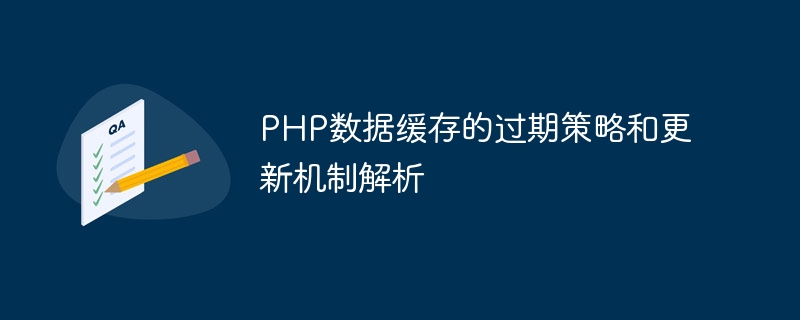

Expiration strategy and update mechanism analysis of PHP data cache
Introduction: With the rapid development of the Internet, the number of visits to the website is increasing, and the processing of data is also increasing. more and more important. In order to improve the performance and response speed of the website, data caching has become a very important technical means. As a common server-side scripting language, PHP has a wealth of caching tools and strategies. This article will focus on the expiration strategy and update mechanism of PHP data cache.
1. Expiration strategy
1. Time-based expiration strategy: This is one of the most commonly used expiration strategies. When caching data, you can set an expiration time. When the data exceeds this time, it will be considered expired and the latest data needs to be reacquired. The implementation of these expiration policies usually relies on caching tool libraries, such as Memcached or Redis.
The following is a sample code that uses Memcached to implement a time-based expiration policy:
// 设置缓存数据
$cacheKey = "user:1";
$userData = array("id" => 1, "name" => "John");
$expiryTime = 3600; // 1小时
$memcached = new Memcached();
$memcached->addServer("127.0.0.1", 11211);
$memcached->set($cacheKey, $userData, time() + $expiryTime);
// 获取缓存数据
$data = $memcached->get($cacheKey);
if (!$data) {
// 缓存数据已过期,重新获取最新数据
$data = fetchDataFromDatabase();
$memcached->set($cacheKey, $data, time() + $expiryTime);
}
echo $data["name"];2. Expiration policy based on the number of accesses: This policy determines whether the cached data has expired based on the number of accesses. and re-fetch the latest data. It is usually necessary to record the number of accesses while caching data, and determine the data expiration at a lower number of accesses.
The following is a sample code that uses Redis to implement an expiration policy based on the number of visits:
// 设置缓存数据
$cacheKey = "product:1";
$productData = array("id" => 1, "name" => "iPhone X");
$redis = new Redis();
$redis->connect("127.0.0.1", 6379);
$redis->hMSet($cacheKey, $productData);
// 获取缓存数据
$redis->hIncrBy($cacheKey, "visitCount", 1);
$data = $redis->hGetAll($cacheKey);
if (!$data || $data["visitCount"] < 1000) {
// 缓存数据已过期或访问次数较低,重新获取最新数据
$data = fetchDataFromDatabase();
$data["visitCount"] = 0;
$redis->hMSet($cacheKey, $data);
}
echo $data["name"];2. Update mechanism
1. Active update mechanism: When the data changes, Notify the cache server for updates in a timely manner. This mechanism is usually suitable for scenarios that require high real-time data performance. Update requests can be sent through command line tools, HTTP interfaces, etc.
The following is a sample code that uses the command line tool to update cached data:
// 数据发生变化
updateDataInDatabase();
// 利用命令行工具更新缓存
exec("php cache_update.php");The contents of the cache_update.php file are as follows:
<?php
$cacheKey = "product:1";
$productData = fetchDataFromDatabase();
$redis = new Redis();
$redis->connect("127.0.0.1", 6379);
$redis->hMSet($cacheKey, $productData);
?>2. Passive update mechanism: when data When a change occurs, the cache server is not actively notified. Instead, it waits for the next cache expiration before re-obtaining the latest data. This mechanism is suitable for scenarios that do not require high real-time data and can reduce the burden on the server.
The following is a sample code that uses Memcached to implement passive update caching:
// 查询缓存数据
$cacheKey = "user:1";
$memcached = new Memcached();
$memcached->addServer("127.0.0.1", 11211);
$data = $memcached->get($cacheKey);
if ($data) {
echo $data["name"];
} else {
// 缓存数据已过期,重新获取最新数据
$data = fetchDataFromDatabase();
$memcached->set($cacheKey, $data);
echo $data["name"];
}Conclusion: The expiration strategy and update mechanism of PHP data cache are one of the important means to improve website performance and response speed. Understanding and rationally applying these strategies and mechanisms can effectively improve the user experience of the website. Through code examples, we can see how common caching tools and related methods are used in practical applications. I hope this article can be helpful to everyone's learning and practice in caching technology.
The above is the detailed content of Analysis of expiration strategy and update mechanism of PHP data cache. For more information, please follow other related articles on the PHP Chinese website!




